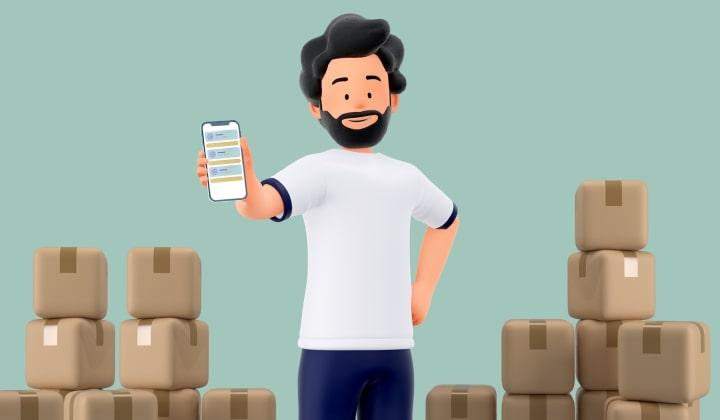There are already too many online stores! Why start another one?
Undeniably, there are numerous stores on the Internet. But you must agree that few of them are attractive enough to purchase there, not to mention coming back.
If you think about how to start an online retail business, in other words — do e-commerce, there is no reason to give up this idea. But first, do comprehensive research, study the issue thoroughly, and take a few important steps. Check them out in our guide.
Let's return to the first point: there are too many online stores. Is this a reason to doubt? Not at all, as online platforms would not be so popular if e-commerce was not a profitable business. More than 70% of people make purchases on the Internet at least once a month.
What can really scare an aspiring retailer is the high competition in the market and the fear of wasted efforts. Therefore, the first step to take when one decides to start an online retail business would be:
1. Study the Market and Competitors
There are two possible options:
• You already occupy your niche, and you know exactly what you will sell • You are only deciding on the domain of your business
In the first case, carefully analyze your competitors’ offers. What do their stores look like? What could you have done differently? What would you have left unchanged? Or suddenly you turn out to be the pioneer in your niche; if so, hats off to you.
Otherwise, if you have nothing but a desire to act, before you start a retail business in the field of e-commerce, we suggest researching the best cities for small business and using embedded business intelligence tools that will help you identify general trends in consumer demand based on various criteria. Try some of these:
• Google Trends • Statista • Keyword Surfer Chrome extension • SE Ranking • Similarweb website and Chrome extension
Additionally, leveraging custom Chrome Extension Development can further enhance your market research efforts by creating tools tailored to your specific needs, such as tracking competitors' pricing strategies or monitoring emerging trends in real time.
2. Get to Know Your Target Audience
What are the needs of your potential customer? Their age, interests, income? Drawing up a detailed customer profiling will help you better understand your target audience, their needs — and find a way to meet them. This insight can help integrate a VoIP phone service to ensure smooth communication channels that match their preferences, improving the overall customer experience. You might also want to consider a Instagram audit to get a better idea of what audience you want to target on social media. Another effective strategy is referral marketing, where tools like ReferralCandy enable you to reward loyal customers for bringing in new shoppers, helping to build trust and drive organic growth.
If you already have a website with Google Analytics installed, then you can easily conduct an in-depth analysis of your audience. In the “Audience” tab, you will see the information about your customers’ places of residence, devices used, categories of purchased goods, and other parameters of interest.
Having these parameters analyzed, the question of how to start an e-commerce business will be almost resolved.
You will see your store visit statistics on the chart.
3. Register Business
Settle all legal issues. Different countries have different business registration procedures. For instance, if you open an LLC every state has different regulations, so there is no universal guide here. Before you decide to open an LLC, make sure to consult with a legal expert to understand the implications for your business. The operations you definitely need to conduct after deciding on the store domain are:
• Sound out the taxation procedure • Register a trademark • Obtain the licenses and permits required in your area
If you are in doubt about your own abilities, you can always seek the help of a specialist i.e. LegalZoom, Incfile, etc. It is much easier to start a small online retail business if you have someone to rely on.
4. Consider Your Brand Concept
Proper brand management will help build strong relationships with your customer and sell retail online more efficiently. Make the name of your online store memorable, but clear and self-explanatory.
Of course, it is better if the brand name is your invention. However, artificial intelligence has already stepped far enough to help you even with this issue. Squadhelp is a useful business naming tool. All you need to do is enter a few keywords, set the length and the desired style of the name.
The designer will create a logo that matches your store’s theme. Consider the psychology of color when deciding on the color scheme of the logo and the future site/application. You can also turn your logo into a QR code to place on products, enhancing your brand identity while making it easy for customers to provide feedback directly.
Don't forget to register your brand trademark. This will protect the logo, fonts of your choice, and unique content from copying.
While considering your brand concept and how to make your online retail store unique, understanding drop shipping can offer a valuable angle. If traditional inventory methods seem daunting, explore innovative dropshipping strategies which allow you to sell products without holding stock. For comprehensive information on this approach, check out these dropshipping tips.
5. Develop a Business Plan
You need a business plan, regardless of the size of your business, the industry, the store’s theme, and the production volume. Having set specific goals at the very beginning (we already wrote about the importance of numbers here), later on, you will understand that you are going in the right direction or doing something wrong. You should consider not only how to start an online store, but also how to proceed.
Review your progress regularly and record your achievements. This will help you understand the rate of your development and identify trends depending on various factors, such as time of year.
6. Decide on a Supplier
If you're arranging supplies, it's crucial to consider the best route planner for logistics. Are you selling your own-produced goods or are you going to arrange supplies? Pay attention to this issue as well.
If you have a product supplier, you need to work out the legal side of your cooperation and organize logistics. When arranging supplies, it's crucial to factor in supply chain sustainability, ensuring your logistics are not only cost-effective but also environmentally friendly and efficient. Try to make it as fast and inexpensive as you can.
If the question of finding a supplier is not relevant for you, the next step would be to start setting up your production, purchasing raw materials, and looking for a warehouse. Perhaps you, as a manufacturer, know more about this than we do, so the main thing here is not to lose sight of anything.
7. Start an Online Retail Store
Finally, it is time to put your platform online. Many online stores are created using builders that offer a ready-made software solution, such as Wix's AI website builder, Shopify, ZipWP, and WooCommerce. These platforms provide a ready-made template that you just need to fill with items. CMS allow you to create an online store with minimal investment and HTML and CSS skills. Many people use builders for reasons of economy and usability.
However, the builders offer limited functionality, and their inexpensiveness is rather conditional. You will have to pay for many useful modules; the domain name and hosting will add costs too. For more advanced functionality and customization, Shopify Plus agencies can help tailor your store to meet specific business needs, ensuring a more professional and scalable solution compared to standard templates.
The soundest way is to entrust the development to specialists. An online store created from scratch will favorably distinguish you among similar sites on well-known CMS. You may need to find a development company to take on your project from scratch.
As a practical example, Jabal, a global B2B platform, partnered with SolveIt to develop a tailored web eCommerce app that connects verified sellers and buyers of small appliances. Our journey began with a comprehensive discovery phase, where we identified Jabal's business objectives, order management needs, and industry best practices. These insights were crucial in crafting a tailored solution that addressed the client's goals. The powerful combination of React's modular architecture and Java's robust data management capabilities enabled us to deliver a scalable and efficient eCommerce web app, capable of handling high transaction volumes and user traffic.
Key features of the platform include a comprehensive order management system with real-time tracking, personalized accounts for buyers and sellers, and a subscription-based monetization model that lays a strong foundation for revenue generation. Additionally, a well-designed landing page enhances visibility and drives traffic, further solidifying Jabal's position in the market. Our ongoing support ensures that Jabal continues to evolve and adapt to the demands of the eCommerce landscape, positioning them for sustained growth and success.
SolveIt will not only develop a unique website and mobile application for your business, but also provide subsequent technical support.
Take care of payment methods convenient for your customers. Integrate payment systems into your online store and think over delivery methods. Implement subscription management software to handle your growing user base.
Despite all the negative aspects of COVID-19, it was not an obstacle for those who have long wanted to start an online store. Nothing ventured, nothing gained, they say; those who took a risk and moved into the online retail business in this period generate even larger amounts than they could before the pandemic.
The coronavirus pandemic has forced millions of people to stay at home and shop online. As a result, marketplaces and online stores experienced unprecedented traffic growth in the second quarter of 2020. It was even higher than peak visits during sales days. In June 2020, online stores worldwide were visited nearly 22 billion times, compared with 16.07 billion visits in January 2020, Statista calculated.
To create a profitable business, one needs to follow the recommendations listed in the article. Special attention should be paid to the quality development, filling the site and mobile application with content, and fast dropshipping, as this is what attracts visitors. Utilizing Shopify development services can significantly enhance the functionality and appeal of your online store. An aesthetically pleasing and usable application is a huge success.
Many countries are gradually exempt from self-isolation, however, the stores moving online and people’s urge to buy there continues to grow. The active growth of the e-commerce market, which began in 2020, does not slow down in 2021. In Russia alone, according to the BI agency Data Insight, over the past year, the market volume grew by 58% and amounted to 2.7 trillion rubles, and its fourfold growth is expected by 2015.
— Veronica Rudman, Business Development Manager at SolveIt
8. Fill Your Store With Goods
Attractive photos and catchy product descriptions get the lion’s share of an online store’s successful sales.
Photographing goods is a real science. To be recognized by customers, you would like to develop your own style of creating photos (e.g., using a special angle or background).
Take the effort to distribute the products into categories and write comprehensive descriptions. Let all the information about the product be in one place so that the customer does not have to look for missing data in other sources. Otherwise, the customer may accidentally stumble upon a competitor — and buy from them, having completely forgotten about you. Rewording the product descriptions can also help make the information more accessible and appealing to the customer.
9. Start Marketing Your Store
For higher sales and involvement, include promoting your store on social media (SMM) in your marketing plan. We recommend you start with understanding Meta Business Suite as it covers two out of the four biggest social media platforms. Most Internet users have accounts on social networks, making the latter an effective tool for promotion. It is important to accompany posts on Instagram handle and Facebook with readable texts: find a copywriter to create them, or master the writing skill yourself. What you can do here is get assistance from an AI tool to write social media posts, such as an AI paragraph generator or a reword generator that can help you create readable descriptions. Using AI writer is a quick solution when you don't a reword generator a copywriter, ensuring your Instagram and Facebook posts still grab attention and promote your store.
Note: on social networks, you need to not only attract users to your site, but also share useful and interesting information. Otherwise, your page will look like an advertising banner, which is not very welcome.
Do not underestimate the importance of search engine optimization (SEO). Two online stores can be found on the first and twentieth pages of search results, respectively, with their contents almost identical. This is due to SEO optimization — or lack of it. With an SEO tool like Surfer SEO tool, you can improve your rankings by tracking keywords and providing insights via an SEO performance report. Additionally, using SEO hosting can further enhance search rankings by ensuring fast loading speeds, optimized server locations, and improved website performance, all of which contribute to better SEO results. Learn more about business advertising in one of our previous articles.
Conclusion
In this article, we have listed the basic steps to online retail business if you decide to start an online retail store. Having launched a retail business and gained enough experience, you will definitely find what to complement our list with.
Our last tip is: don’t postpone the creation of an online store if you have already made a decision. You can wait for the right moment to fulfill your plan as long as it takes, and there will always be reasons for starting another time. But remember: the success of your idea depends only on you!
Launching your online retail business is exciting. While you focus on choosing a niche and building your online store, don't forget the financial side of things. Using an accounting app can streamline your finances and expense management from the start. This will make tracking sales, managing inventory, and understanding your profit margins a breeze.
SolveIt will gladly take over the development of the website and mobile application so that you can pay as much attention to business development and earning revenue as possible. Contact us in any convenient way, and we will answer all of your questions.



